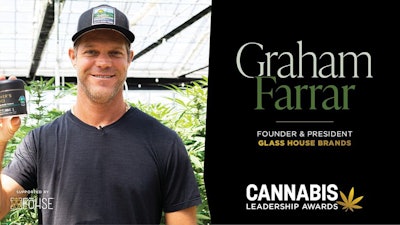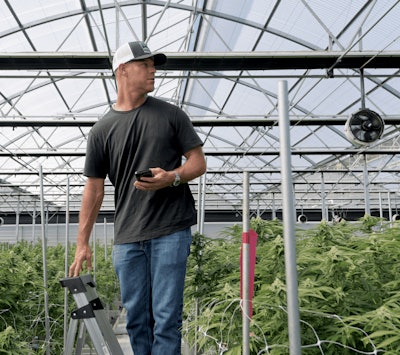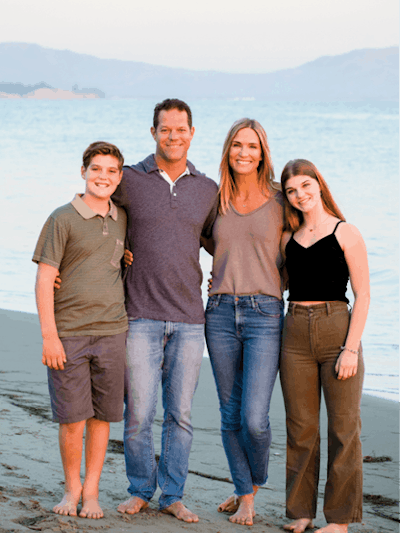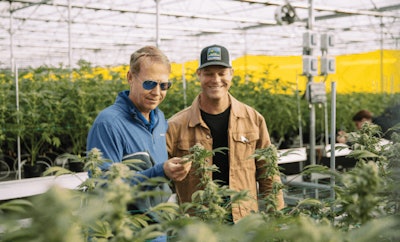

As founder and original CEO of Glass House Farms and co-founder and president of Glass House Brands (formerly Glass House Group), Graham Farrar’s reputation for passion, achievement and leadership continues to grow. Under his guidance, Santa Barbara-based Glass House Farms has grown to encompass more than half a million square feet of sustainably grown, craft-at-scale cannabis in just six years.
Earlier this year, Glass House Group completed a de-SPAC (special purpose acquisition company) transaction that took the company public, officially changed its name to Glass House Brands, and significantly enhanced its balance sheet. That sets the stage for the vertically integrated company’s exponential expansion in cultivation and retail—including a 120-acre, 5.5 million-square-foot greenhouse now in its sights.
But behind the excitement is a hometown-kid-made-good, who counts himself lucky to be cultivating cannabis and community in Santa Barbara County. It’s where he grew up and where he and his wife, Sara, raise their two kids. “I don’t know if it’s serendipity, or the harder you work, the luckier you get,” Graham says. But this industry leader’s backstory suggests more than good fortune is at work.

An Uncommon Course
Growing up in Santa Barbara as an only child, Graham discovered the new frontier of computer technology in his middle school years. The young tech entrepreneur soon had a side hustle providing freelance tech support.
Unchallenged at school and failing by traditional standards, he dropped out of high school and got his GED. However, he always had an interest in medicine. When he enrolled in science classes at Santa Barbara City College, he went from high school Ds and Fs to a 4.0 GPA. On track for medical school, the University of Colorado-Boulder was Graham’s next stop. There he fed his affinity for science and math with a molecular biology and biochemistry double major.
It’s also where he met Sara, at their very first college party 27 years ago, in 1994. That night, she got a glimpse of life ahead. Just 17 years old, she was determined to focus on her freshman year and forgo a boyfriend. But Graham had other plans.
“He was relentless,” she says, laughing as she speaks. “The first night, I told him what dorm I was in, and he went around and knocked on every single door until he found my room, which is very indicative of his personality.”
He didn’t give up. A mutual friend joined the effort, concocting elaborate set-ups so that Graham would “randomly” run into Sara. They finally started dating in April of their freshman year. “He went from a straight-A student to like a D student,” she shares, still laughing. “He gets very into whatever he’s into. He’s kind of an all or nothing guy, and just really goes after what he wants.”
Tech and Travel
Though Graham is well known in the cannabis industry, his earliest formal business experience came from tech. Following his freshman year at Boulder, Graham pivoted away from medical back to computer science, got an internship and, eventually, a job offer at a Santa Barbara software company during the dotcom boom. He dropped out of college and never looked back.
The company was Software.com, an early leader in the burgeoning tech industry that helped make email possible, providing internet messaging solutions to clients worldwide. Soon Graham was traveling internationally for the company. Sara transferred to Santa Barbara.
“He had this shoulder-length hair and would wear these tacky Hawaiian shirts,” Sara recalls. “He was just this little dorky kid, but all of a sudden, he’s working for this software company, and they ended up going public.” That was 1999 and Graham was 23. He sold some shares of the newly public company and bought, among other things, a 46-foot sailboat.
Despite a total lack of sailing experience, he convinced Sara to live on the sailboat and sail the world. They went to San Diego and took a two-week sailing course. Then they sailed to New Zealand over the next two years, just the two of them. That was after convincing her parents, including her sailor dad, that they could safely make the crossing from Mexico to the South Pacific—23 days at sea without land.
“Graham’s just so resourceful and good at figuring things out and just keeps at it until he gets it. Living on the boat with him was just really when I saw that,” Sara says. “For him, no problem was too big that he could not get everything figured out.”
They would have kept sailing if it weren’t for a Thanksgiving visit back to the States. Graham’s former boss at Software.com had started a new company and wanted Graham onboard. That company would evolve into Sonos, the forerunner in wireless home sound systems.
He sold the boat and moved back to Santa Barbara. He and Sara got married in 2004. They later had two children—a daughter, now 15, and a son, now 11.
A few months after their daughter’s birth, friends asked them along on another boating adventure—this time complete with a crew. It was another two-year trip. One year in the Mediterranean, one year in the Caribbean. “Our daughter was one when we left and three when we got back,” Sara says.
Segue from Software to Precision Ag
Graham describes himself as a “tech geek by business training and experience, but a cannabis lover by passion.” A vocal supporter of cannabis, he became a consumer early on and dabbled with homegrown in closets over the years. He’d always been fascinated with the plant and began applying his tech background, studying the impact horticulture technology could bring to cultivation. Eventually, his passion for cannabis won out.
“I actually remember the moment he said, ‘I think I’m going to get into the cannabis industry.’ It was just one of those moments in time that you remember clearly,” Sara says. “I don’t remember feeling apprehensive about it at all. I just really trust his judgment.” But not everyone in the family would feel the same way.
By 2014, Graham was convinced California’s adult-use market was approaching fast. He and some friends launched an ancillary business called Elite Garden Wholesale, selling fertilizers and growing systems. They targeted larger-than-hobby-scale cannabis growers on track to become the new commercial market’s core.
“One of the things that makes him a great leader is that he will listen. He’s not the kind of person that just wants a simple answer. He wants the full explanation.” Devin Granados, Senior Operations Manager, Glass House Farms
It wasn’t long until his daughter, then 9 years old, found an Elite business card. She asked questions; Graham and Sara answered truthfully. Fresh out of D.A.R.E. training at school, Dad’s new line of work was tough to swallow. “She really had a hard time with it,” Sara says. “She just told us pretty recently that for a long time, when asked what her dad did for a living, she would just say he has a 9-to-5 job. So those years were interesting.”
Graham remembers her running to her room and crying: “She thought, ‘Dad’s a drug dealer’ because that’s what her teacher had just told her.” Six years later, a lot of things have changed. “Now, of course, all of her friends think it’s the coolest thing any dad could do, so she’s totally fine now,” he says.
Along the way, Graham started helping growers learn how to use Elite products. Then the proverbial eureka moment came. “We realized that we know this plant better than [our customers] did. We’re teaching them how to grow so we can have them as a customer of our products. Why aren’t we just doing this? Why don’t we have the greenhouse?” Graham recalls.
In 2015, he went from selling to farmers to being the farmer. Glass House Farms was cultivating in a Carpinteria greenhouse, and Graham forged a partnership with Kyle Kazan, now co-founder, chairman and CEO of Glass House Brands.
Lessons in Leadership—and Loyalty
Graham began Glass House Farms with lofty goals, purchasing the company’s first 150,000-square-foot greenhouse from a flower grower. The greenhouse was highly automated with all-glass roofs, Graham says. And then it was retrofitted to grow the cannabis plant. It was an enormous undertaking.
“There’s a thing called the Dunning-Kruger effect, which is when you don’t know anything, you don’t know that you don’t know anything, and then you get educated, and you realize that you don’t know anything, and then you actually become an expert and do know something,” he says, noting that his optimism and confidence benefited the team. “Somehow, we pulled it off,” he adds.
The first farm was used as a launching pad to purchase the second farm, which was 355,000 square feet. Today, the company employs about 480 cannabis professionals, and is on track to purchase even more cultivation space to eventually produce 5.5 million square feet of greenhouse-grown cannabis.
Sara is especially proud of Graham’s connection with his employees. “He is an amazing boss, and all of his employees really love him, from the workers at the farm to the office,” she says. “He really cares about people. He puts a lot of thought into just how he runs his business and how his employees are treated and really leads from his heart on things.”

Glass House Farms Senior Operations Manager Devin Granados agrees. With Glass House since 2016, she describes employees across the board as having “undying loyalty” to Graham. She attributes the company’s financial success to the culture Graham created and the compassion he has for people.
“One of the things that makes him a great leader is that he will listen. He’s not the kind of person that just wants a simple answer. He wants the full explanation,” she says. “He wants to know the ‘why.’ He wants to know the ‘how.’ He wants to see how you how you came up with a decision, and encourage you to come up with new ideas and grow the business yourself.”
His work ethic stands out as well. “Graham’s an incredibly hard worker,” Devin says. “He’s constantly thinking and brainstorming and working and trying to set up new ideas and trying to be innovative. And that attitude really trickles down to the rest of the company.”
In setting that tone of leadership, Graham says, “If you think you’re going in the right direction and you think it’s worthwhile and you just refuse to quit, eventually you’re going to get there.” But there’s no guarantee it’ll be easy or be a straight line. He describes the leader’s role as seeing ahead, as best you can, then preparing your team to successfully overcome the challenges you’ll meet together.
Asked how other team members would describe Graham, Devin reels off a list: smart, fun, compassionate, trusting and humble.
Loyalty runs both ways. “We’re building a team, which means full-time employees,” Graham says. That translates to company-paid health benefits, vacation days, sick days and 401(k) access. Plus, almost everyone has some level of equity participation. If Glass House does well, so do they.
He says the hiring process isn’t unique. “I think our biggest thing is that we treat people well. We’re trying to build a family and a team, and people who work here tell their friends and their family about it, and that’s probably our biggest source of referrals and recruitment.”
Community Reinvestment
Despite traveling to five or six dozen countries and living four years on boats, Graham says he’s never sad to come home to Santa Barbara. Personally and professionally, he works extensively to give back to the community that helped nurture him and supports his success.
He spent several years on the board of Heal the Ocean, a local non-profit fighting for a clean ocean, and Seacology, a worldwide organization working to protect threatened island ecosystems. He currently sits on the board of the Santa Barbara Bowl Foundation, which manages, maintains and renovates the Santa Barbara Bowl, a more than 4,500-seat amphitheater—a position he’s held for more than a decade. He’s heavily involved with the foundation’s education and outreach programs.
Giving back to the community is a cornerstone of his role as a cannabis industry leader. “I think cannabis has such a history, a foundation of compassion, and it’s something that we try and keep going,” Graham says.

Glass House organizes fundraisers for the Freedom Warming Centers, a local home shelter system, and for food banks. “He does care a lot about trying to close the gap between the wealthy and the poorer classes,” Devin says.
Sue Taylor, who partnered with Glass House to launch three tinctures under her Mama Sue brand using Glass-House-grown plants, praises both Graham’s character and cultivation standards, and shares a story that she says illustrates his devotion to the community.
“[Graham] wanted to donate money to the schools. But the schools said they would not take marijuana money. So you know what he did? He started growing tomatoes and made hot sauce and began selling it at farmers’ markets and different venues, and they took that money from the hot sauce sales,” she says. “[Glass House is] committed to giving back to the universe and giving back to the earth.”
Graham and Glass House are also members of the Cannabis Association for Responsible Producers, aka CARP Growers. This local non-profit trade organization promotes best practices to enhance positive, respectful relationships with their Carpinteria Valley neighbors. Their work spans everything from odor control to extensive charitable endeavors.
When COVID-19 forced local Santa Barbara restaurants to shutter dine-in services, the group launched a program called Keep the Lights On. CARP members ordered twice-weekly deliveries, amounting to thousands of lunches for their employees, to help support Santa Barbara’s restaurant industry.
Social justice is an all-encompassing concern for Graham and Glass House. They’ve worked with Last Prisoner Project, Color of Change—an online racial justice organization—as well as helping some individuals to get out of the jail system. “I’m going to connect the flywheel of our success to trying to correct some of the wrongs in the past … whether it’s prisoner release, or record expungement or both, I think that’s something that we should be able to help with,” he says. “I think every day that goes by where a family is torn apart and someone is sitting in jail for a plant is a day too long. And I hope it’s something that the industry will come together on, because it’s going to take all of us to even have a chance of fixing it.”
What Drives Graham?
Graham has experienced success with other companies, but Sara says this time with Glass House is different. “This is his company. He really wants to knock it out of the park on a company that he starts himself,” she says.
While that desire motivates him, she says their children fuel that relentless drive. “He wants everything for them, so that’s definitely behind everything—showing them what it looks like to work really hard and doing everything he can to create a good life for them.”
She describes the kids as “super-proud” of Graham, who somehow keeps it all balanced. “He’s not coaching the soccer team, but he never misses a game to the best of his ability. He’s always at the important things, and whenever we need him, he’s there for us,” Sara says. “I think that says a lot considering how much is on his plate.
“It’s really been just an honor to be his wife and watch him go through this pretty incredible journey. He’s the hardest working guy I know, and it’s really cool to see it all starting to come together after all these years.”
















